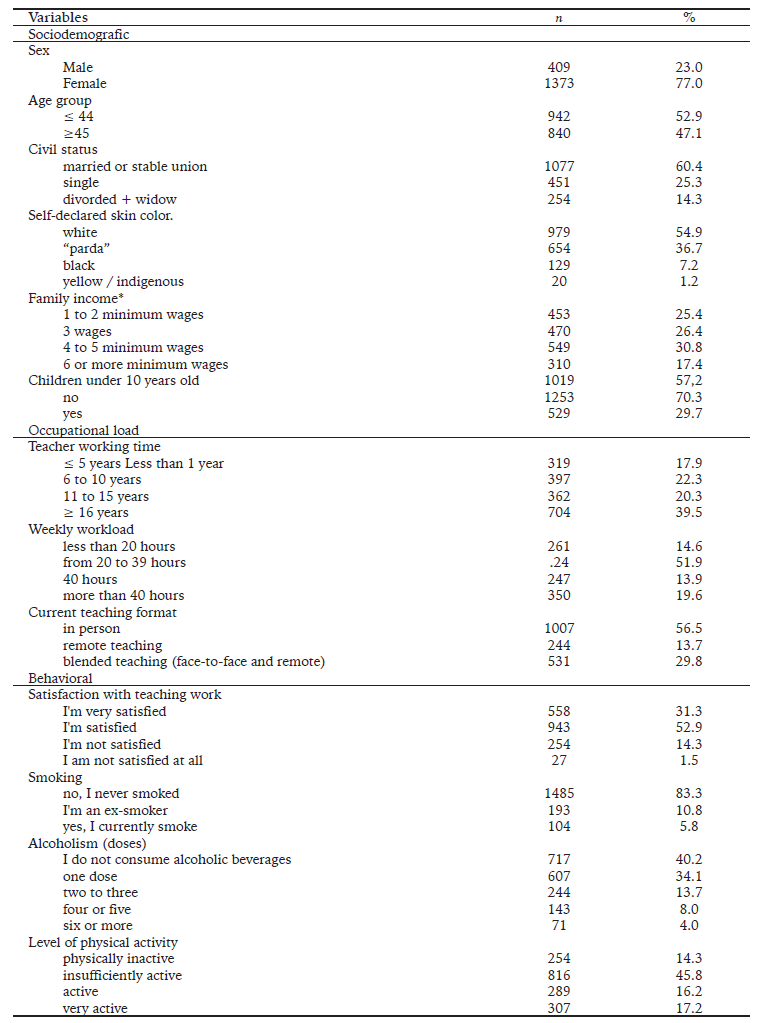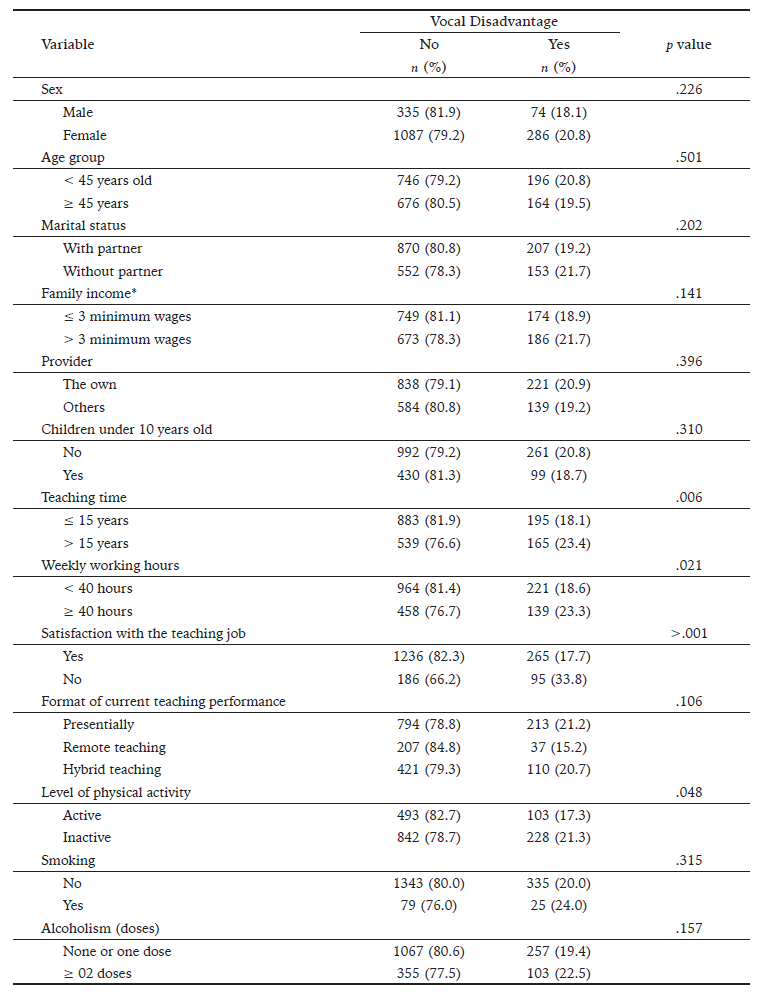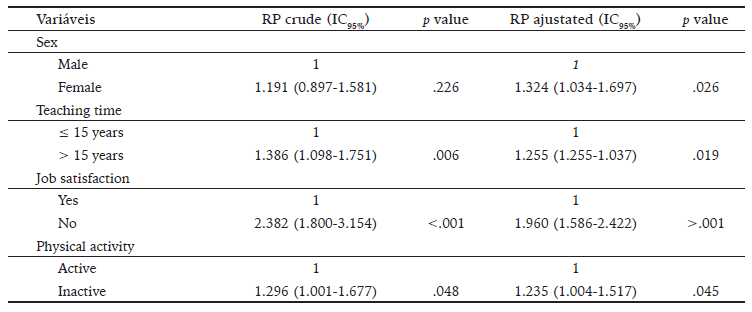Introduction
Among the professional categories that use the voice, teachers stand out regarding the development of dysphonia. A critical issue to be reported in the educational environment is COVID-19, which has been causing damage and being a challenge in education because it has led to the interruption of face-to-face classes and the change to online teaching and remote education (Rosa, 2020). With the decreasing trend in cases, activities were returned throughout Brazil (Ximenes et al., 2021).
Research has shown that the prevalence of vocal disorders during the pandemic was lower than during face-to-face classes due to using the voice with less frequency and intensity (Campos et al., 2022). Another critical point was observed in a study during the pandemic: teachers dissatisfied with their teaching work were among those who did not practice physical activity (Silva et al., 2021). Insufficient physical activity may be a predisposing factor for vocal disorders, but there are few studies to verify such an association (Santos et al., 2019).
To better understand the impact of dysphonia, the Vocal Disadvantage Index (VDI) has been employed both in Brazilian research and in other countries such as Malaysia (Moy et al., 2015), Saudi Arabia (Alanazi et al., 2018; Alkhunaizi et al., 2022) and Kuwait (Alarouj et al., 2022). This questionnaire makes it possible to quantify the individual’s perception of their vocal disorder (Andrade et al., 2016).
In this sense, there is interest in researching teachers’ voice use at a time that has been moving toward the new normal concerning face-to-face classes. Therefore, the present study aimed to verify the association between vocal disadvantage and socio-demographic, occupational, and behavioral variables in teachers of the public network of Minas Gerais.
Methods
This is an epidemiological, cross-sectional correlational study with a representative sample of teachers who work in elementary and high school in-state public schools in Minas Gerais, Brazil.
Sample
The sample was calculated based on the total number of teachers working in the year of collection (n = 90.000), using the formula based on a prevalence of disease (or event) of 50% to obtain a larger sample size, tolerable error of 3%, the confidence level of 95% and double sampling (Diff = 2). This calculation added a value of 20% for the non-response rate (individuals who did not agree to participate in the study). The minimum expected sample of 1.068 teachers, to guarantee the representativeness of these teachers for the state of Minas Gerais and to avoid possible losses (non-response rate), 20% was added, totaling 1.282 teachers.
The sample selection occurred by conglomerates based on access to the list of state schools in the state and their number of teachers, made available by the Secretary of Education of Minas Gerais, which allowed the identification of the total number of teachers and their distribution according to the Regional Superintendence of Education (SRE) to which the teacher was linked, ensuring the proportionality of teachers per superintendence, i.e., it was a probabilistic sample, in which groups, or clusters randomly selected individuals. All elementary and/or high school teachers working in one of the state schools in Minas Gerais were eligible. Those not contacted were considered sample loss, and those who did not want to answer were considered refusals. As exclusion criteria, we considered teachers with a job deviation or on temporary leave from their position.
Data collection took place between October 26 and December 31, 2021. The data collection instrument (tested and corrected in a pilot study), developed in the online platform called Google Forms®, had its access link sent to the institutional e-mail of all participants, which required the support of the Regional Education Secretaries (SRE) and school principals. The form, structured in descriptive topics with the questions grouped in blocks, sought to collect information about the socio-demographic and economic profile, work conditions, health situations, habits, and behaviors of primary education teachers from the public network of the state of Minas Gerais. In order to guarantee the anonymity of the participants, a code was attributed to each form received, through which all the procedures of data tabulation, systematization, and analysis took place.
The researchers contacted the State Department of Education of the State of Minas Gerais. They obtained authorization to carry out the study, and the project was submitted to the Research Ethics Committee of a public university. Each Regional Superintendence of Education received a link to the questionnaire to send to the school principals and teachers.
Instruments
The instruments were grouped into a single questionnaire in digital format, using an online form (Google Forms®), along with the Informed Consent Form. The dependent variable was a vocal handicap, and the questionnaire included the following independent variables: socio-demographic (gender, age, marital status, self-reported skin color, income, number of children); occupational (length of service, weekly workload; mode of activity of the classes); behavioral (job satisfaction, smoking, alcoholism, physical activity).
The Vocal Disadvantage Index 10 (VDI-10) (Costa et al., 2013) is composed of ten questions that incorporate five items from the functional domain, three from the organic domain, and two from the emotional domain; with possibilities of answers on a five-point Likert-type scale (never, almost never, sometimes, almost always, always). The questionnaire makes it possible to quantify the individual’s perception of his or her vocal alteration, and the higher the score, the greater the vocal disadvantage perceived by the subject (Andrade et al., 2016). It is a tool that produces a single total score, calculated by simple summation of the responses of its items, and can range from zero to forty points, with zero indicating no disadvantage and forty indicating maximum disadvantage (Costa et al., 2013). The cutoff score is seven and a half points when the instrument is used for vocal screening. A score above this value indicates the need for a referral for a complete vocal evaluation (Gimenez et al., 2019).
Job satisfaction was measured based on the question, “Are you satisfied with your job?” with four response options (I am very satisfied, I am satisfied, I am not satisfied, I am not satisfied at all). Subsequently, this variable was dichotomized into yes and no (Assunção & Pimenta, 2020). Concerning smoking habits, it was questioned from three items (no, I have never smoked; yes, I currently smoke; I am an ex-smoker). As for alcoholism, it was asked how many doses of an alcoholic beverage are typically consumed when drinking (no alcoholic beverage consumption; one dose; two to three doses; four to five doses, six or more doses). This variable was dichotomized into no alcoholic beverage consumption (none or one dose) and greater than or equal to two doses.
Physical activity was assessed by the International Physical Activity Questionnaire (IPAQ) in its short form, validated for the Brazilian population (Pardini et al., 2001). This questionnaire consists of eight questions that assess the duration and intensity of physical activity of the individual during a “usual” week in occupational, locomotion, leisure, or sports activities. We used the classification of individuals as to the level of PA based on the weekly frequency and time spent on the practice of activities. Participants who reported exceeding the recommendations for vigorous practice were considered very active; those who performed at least 150 minutes of weekly physical activity for five or more days a week were classified as physically active; those who reported physical activity above 10 minutes and less than 150 minutes daily were classified as insufficiently active; and those who reported performing less than 10 minutes of physical activity daily were considered inactive (Matsudo et al., 2012). Subsequently, this variable was dichotomized into active and inactive.
Statistical analysis
For data analysis, absolute and relative frequency calculations and measures of central tendency were performed to describe the sample. Subsequently, Pearson’s chi-square calculation was performed at the 25% level (p < .25). Multivariate Poisson regression analysis was performed to evaluate the factors associated with vocal handicap with the input of all variables and a robust significance level of 5% (p < .05) was adopted. Data were tabulated and analyzed using IBM SPSS 20.0 (Statistical Package for the Social Science) statistical software.
Results
A total of 1782 teachers participated in the study. The majority were female (77.0%), mean age of 44 years (± 9.33), with a minimum of 21 and a maximum of 72 years. Other data are presented in Table 1. Vocal handicap was present in 20.2% (n = 360) of the teachers.
The variables associated in the bivariate analysis up to 25% were gender, age group, marital status, family income, provider, children under ten years old, time teaching, weekly workload, job satisfaction, the format of teaching performance, level of physical activity, and alcoholism (doses) (Table 2).
In the multivariate analysis, female gender, length of teaching tenure, job dissatisfaction, and physical inactivity were associated with statistical significance for vocal handicaps (Table 3).
Table 1: Description of The Sociodemographic, Occupational, And Behavioral Profile By Absolute And Relative Frequencies. Minas Gerais, Brazil, 2021.

Table 2: Association Between Sociodemographic, Occupational, And Behavioral Profile And Vocal Disadvantage. Minas Gerais, Brazil, 2021.

Discussion
The vocal disadvantage of Brazilian teachers participating in this study was below the prevalence of 21.6% verified in a recent survey, with teachers in Riyadh, Saudi Arabia, who taught in the tele-teaching modality (Alkhunaizi et al., 2022) and below the values found in the study conducted in the city of Salvador - Bahia - Brazil, whose prevalence was 21.3% and 28.8%, depending on the vocal effort evaluated regarding the number of years of work and weekly workload (Sampaio et al., 2012). However, it was higher than the 10.1% (Moy et al., 2015), 17.3% (Alarouj et al., 2022) and 18.3% (Alanazi et al., 2018) conducted with teachers in Malaysia, Kuwait and Saudi Arabia respectively. Such differences may be due to using the IDV cut-off point above 11 points, the modality and teaching, and the research time. These factors can be considered as limiting for comparisons between the results found.
In the present study, the vocal handicap was associated with the female gender, teaching time, job dissatisfaction, and physical inactivity. As for the association with the female gender, studies showed that female teachers scored higher on vocal handicaps than their male colleagues (Alafarj et al., 2022; Alarouj et al., 2022). Prolonged voice emission and in use of increased loudness, supposedly caused by anatomical and functional distinctions and adapted adjustments, are presented in several studies as a justification for the relationship of vocal alterations in women (Caporossi & Ferreira, 2011). This difference between the sexes may also be related to the greater perception of the female gender regarding the emotional and physical response concerning vocal production (Albustan et al., 2018).
Teachers with more than fifteen years of teaching time scored higher on the vocal handicap index. Studies show that the longer time of exposure to the teacher’s activity is associated with a higher frequency of harmful effects on the voice, whether these effects are short or long-term, with emphasis on the increase of signs and symptoms according to the intensity of the workload exercised. A study of medical records of teachers readapted due to dysphonia found that most had an average of 18.5 years of teaching (Spitz, 2009).
Research to interpret the results of studies of epidemiological sources verified that there is an association between poor working conditions and dissatisfaction (Assunção & Oliveira, 2009) and, consequently, to vocal problems, which means that the overlapping of tasks contributes to the physical, vocal and mental wear of teachers (Assunção & Oliveira, 2009). A study identified that teachers with voice disorders present twice as much dissatisfaction with the work environment compared to teachers who do not have the vocal disorder (Bermúdez et al., 2010).
Dissatisfaction with the teaching activity causes damage to occupational performance in intensity equally proportional to the possible relationship of satisfaction with work optimization. The dissatisfaction affects personal living conditions and the quality of occupational performance (Silva et al., 2021). Moreover, unhealthy working conditions are a proven risk factor for teachers’ vocal health, valuing the primordiality of regular physical activity as a propulsive tool to promote this professional’s quality of life and health. Although teachers claim that the effects of regular physical activity are beneficial for health maintenance, quality of life, and well-being, it was observed that more than half of the teachers in this study need to be more active. There is scientific evidence that physical activity three or more times a week can be beneficial for voice (Santos et al., 2019) and is a protective factor for reducing the prevalence of vocal disorders (Santos et al., 2019). However, in a meta-analysis on risk factors for vocal disorders in teachers from 2000 to 2018, physical activity was not significantly related (Byeon, 2019).
Such divergences can be explained by the different instruments used for both vocal and physical activity assessment. However, it is essential to note that questionnaires remain the most widely used measurement tool in large-scale studies due to their efficiency across large populations. Numerous validation studies suggest that IPAQ has high reliability, convergent validity, and moderate validity compared to accelerometers (gold standard).
The present study had limitations. The voluntary participation of the population may generate a self-selection bias in the results, targeting particular interest in participation since the methodology used a WebSurvey. This data collection modality has limitations regarding the mechanism, and the collected results need interpretation according to how they are elaborated. Another important aspect concerns the ethical care and protection of internet servers so that they offer reliability and do not allow the alteration of data by third parties (Boni, 2020).
It is known that not always those who have voice disorder perceive it as a problem that affects their lives. However, the results’ relevance should be highlighted, and it is important to point out that self-assessment questionnaires are helpful, valid, and reliable instruments. According to Albustan et al. (2018), although the VDI assesses the perception of vocal impairment independent of the physical condition of the larynx, it can be used next to objective methods to identify vocal disorders.
Further studies aimed at contributing to further elucidations about vocal handicaps and teaching performance are suggested since the subject is insufficiently addressed in the literature and has the potential to be deepened to characterize the level of interference of the variables.
Conclusion
The present study, carried out at the beginning of teachers’ return to classroom teaching, verified that one-fifth reported the perception of vocal handicap associated with the female gender, which obtained a higher score. Teachers who have been teaching for more than fifteen years scored higher, and similar results were obtained regarding dissatisfaction with work and physical inactivity.















